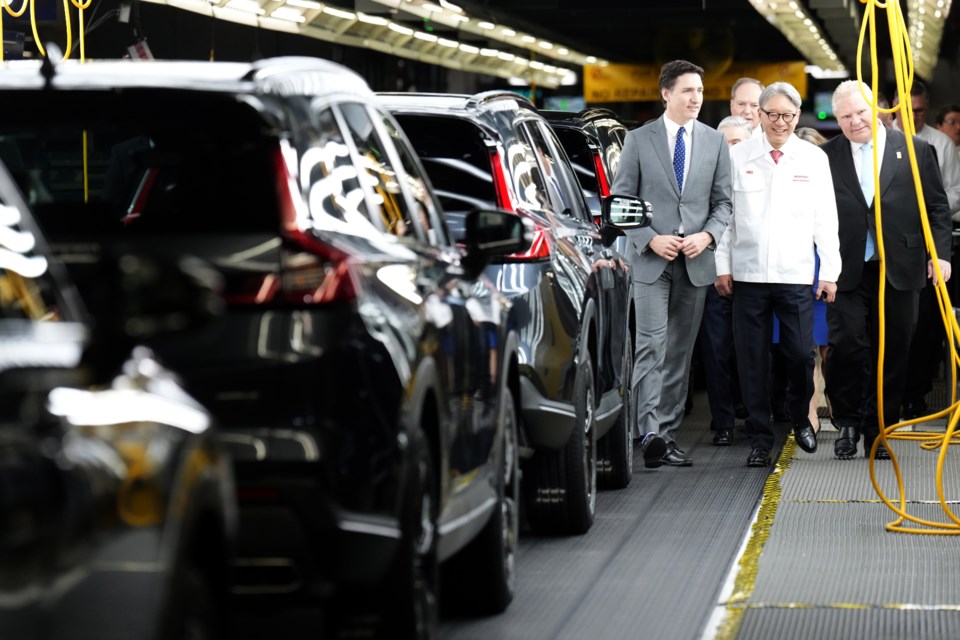This article originally appeared on The Trillium, a Village Media website devoted exclusively to covering provincial politics at Queen’s Park.
Another one of the world's biggest automakers is betting big on Ontario as an electric vehicle powerhouse.
On Thursday, numerous top government officials — including Canada's prime minister and Ontario's premier — and Honda Canada executives came together at one of the company's plants in Alliston, Ont. to announce it would be spending $15 billion to build four new manufacturing facilities in the province. Altogether, the manufacturing plants will form "Canada's first comprehensive electric vehicle supply chain," a news release from the two governments said.
To secure "the largest investment Honda has ever made in North America," as deputy prime minister Chrystia Freeland put it, the Governments of Canada and Ontario have promised the company around $2.5 billion apiece.
The four new manufacturing plants will create more than 1,000 new jobs in Ontario, officials from both governments said. Thousands of "spin-off" job opportunities — including in construction — are also expected to be created as a result of Honda's investment, according to Premier Doug Ford.
Honda currently employs over 4,200 people in Alliston, a town of about 25,000 that's roughly 40 kilometres southwest of Barrie. Two of its new EV-focused plants will be built in Alliston as well. "Once fully operational in 2028, the new assembly plant will produce up to 240,000 vehicles per year," the two governments' news release said.
Honda expects to finalize and announce plans for its new facilities by later this year.
It wasn't disclosed on Thursday where Honda's other two new plants will be located. These facilities will produce EV battery components.
Honda's goal is to sell only EVs and fuel cell electric vehicles (FCEVs) by 2040. The Trudeau government has set 2035 as the target for when all new light-duty vehicles sold in Canada will be zero-emission.
The funding "in the range of $2.5 billion" that the federal government plans to give Honda will come through two tax credit programs, including one tailor-made for Honda's announcement that Prime Minister Justin Trudeau's Liberals introduced in their 2024 budget a couple of weeks ago.
Provincial government funding "of up to $2.5 billion" to Honda will be provided via "various direct and indirect incentives," the governments' news release said.
Ontario closer to another link in its EV supply chain
The Ontario government is also closing in on an agreement with a First Nation that would clear the way for the first 80 kilometres of a road to the Ring of Fire to be built, Ford said on Thursday.
A deal between the provincial government and Aroland First Nation is “that far away,” Ford said, demonstrating at the news conference how close the two sides are to an agreement with an almost pinched-together thumb and index finger.
Ford also teased an announcement earlier in the week at a municipal conference, saying attendees would “hear more news about the road to the Ring of Fire very shortly.”
The Ring of Fire is a mineral-rich area about 400 kilometres northeast of Thunder Bay in northern Ontario, which doesn’t currently have all-season road access. The Ford government sees unlocking deposits of minerals like cobalt and chromite in the area as a key component of its plan to create an end-to-end EV supply chain in Ontario.
On Thursday, Ford said building roads to the Ring of Fire isn't just about extracting minerals to bring south.
“We're going to bring in broadband up there," the premier said. "We're going to be able to have access by road all year round — access by road, it changes people's lives. We're gonna make sure that we get the electricity up there, so they don't have to rely on diesel. That's what we're doing."
Part of the closest highway to the Ring of Fire runs through the territory of the Aroland First Nation, which would be one of the southernmost First Nations directly affected by a road being built — and a likely starting point for the road. Aroland sits about 300 kilometres south of the future mining area, and about an hour north of Highway 11, which connects much of northern Ontario.
In March 2023, the Ford government reached a deal with Webequie and Marten Falls, two of the First Nations closest to where mining companies hope to extract minerals, to set in motion a process aimed at getting most of an all-season road corridor built in the area. Work required by law to assess the environmental impacts of road projects totalling hundreds of kilometres in length are ongoing.
Ford’s push to develop the region has alienated several First Nations leaders. Cat Lake First Nation Chief Russell Wesley received an injunction last month to stop the construction of a road to a gold mining project, alleging the government failed to consult them.
First Nations leaders have also said Ontario’s online system for staking mining claims has swamped them with requests and must be fixed.
Northern Development and Indigenous Affairs Minister Greg Rickford said on Tuesday that the road will only be the first step.
“It isn't just about the First Nations communities that are most proximal to the Ring of Fire. The whole north-central part of northern Ontario needs to be developed,” Rickford said, adding that energy corridors and other types of legacy infrastructure need to be built before the mining operations can get up and running.
The Ford government has earmarked $1 billion for the Ring of Fire road and asked the federal government to match that amount. Trudeau's Liberals haven't to date.
Even if the federal government doesn't buy into the plan, Ontario could be prepared to go it alone, Rickford said.
“We've demonstrated a commitment to move forward on the foundational projects that are required for us to move into the North … We're just hopeful that the federal government will join us. It's an opportunity of a lifetime.”
—With files from Aidan Chamandy



